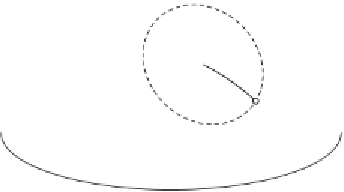Geoscience Reference
In-Depth Information
Substituting (9-18) and taking into account the orthogonality relations (1-
83) and the normalization (1-91), we easily find
=
n
m
=0
nm
+
b
2
∆
g
2
(
a
2
M
{
n
}
nm
)
.
(9-21)
Consider now the average product (9-19) of two Laplace harmonics of differ-
ent degree,
n
=
n
. Owing to the orthogonality of the spherical harmonics,
the integral in (9-19) is zero:
∆
g
n
∆
g
n
}
if
n
M
{
=0
=
n.
(9-22)
In statistical terms this means that two Laplace harmonics of different de-
grees are
uncorrelated
or, broadly speaking,
statistically independent
.
In a way similar to that used for the gravity anomalies, we may also
expand the covariance function
C
(
s
) into a series of spherical harmonics. Let
us take an arbitrary, but fixed, point
P
as the pole of this expansion. Thus
spherical polar coordinates
ψ
(angular distance from
P
)and
α
(azimuth)
are introduced (Fig. 9.2). The angular distance
ψ
corresponds to the linear
distance
s
according to (9-8). If we expand the covariance function, with
argument
ψ
, into a series of spherical harmonics with respect to the pole
P
and coordinates
ψ
and
α
,wehave
C
(
ψ
)=
∞
n
c
nm
R
nm
(
ψ, α
)+
d
nm
S
nm
(
ψ, α
)
,
(9-23)
n
=2
m
=0
north pole
Ã
=const.
®
P
Ã
P'
Fig. 9.2. Spherical coordinates
ψ, α



